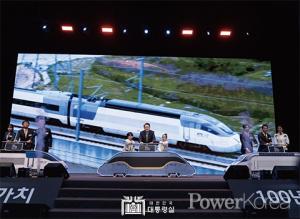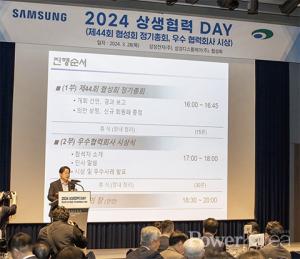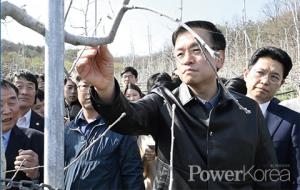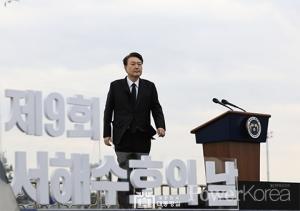- Monk Doseong’s ‘Junjae-keolin’... spreading Mahayana thought with Hwanguk Esotericism
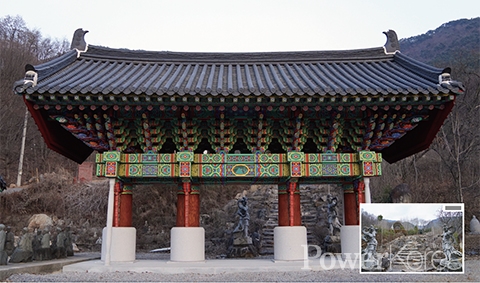 |
||
‘Jineon Buddhism’, which makes a vow to the Pure Land of Buddha, is a religious sect that upholds the three treasures and devotes itself to immediate Buddhahood. The main deity enshrines the Bodhisattva of the Seven Guji Bultomo Daejunjewang, who is Guanyin, and practices the three secret practices with the Shingonji Song Uigwe, and attains the ultimate Consummation of the Supreme Right Enlightenment. It is the dogma that everyone becomes a Buddha. In response, PowerKorea toured Buddhist temples, Buddhist monasteries, and Maum classrooms as a special feature of the Buddhist year 2567 (Dangun calendar year 4356), and looked at the trend of Monk Seongwoo Doseong and his followers.
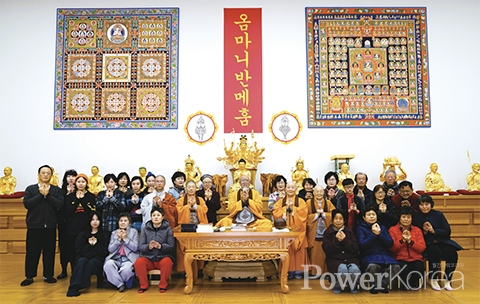 |
‘Iljumun Gate’ built in ‘Beophwasa Temple’, a barren monastery
Samteogol is located in the rapids of Gagok-myeon, Danyang-gun, Chungcheongbuk-do. This is the place where Beophwasa Temple is located (51-15, Yeoulmok 2-gil) under Yongsanbong Peak of Sobaeksan Mountain where the Namhangang River flows. In December of 2022, a large ‘Iljumun Gate’ was built at Beophwasa Temple. The name is ‘Bulmojunjehoesang’. This was achieved after a long-cherished wish by Venerable Doseong along with the Buddhist disciples of this temple. Iljumun Gate has the meaning of being the first gateway to throw off all worldly things and enter the path of learning. This building started construction in January 2022 and was completed over a year by masters of cultural heritage and dancheong craftsmen. The four thick wooden pillars and stones supporting the large roof reveal a sense of beauty as well as grandeur. The dancheong patterns and colors of the pillars, which were worked with sincerity, make the viewers admire. The temple is divided into five floors, with historical and noble statues scattered throughout. In the large yard on the bottom floor, along with the outbuildings, there is Hwangukjeon, where the ancestor of our nation, Hwanin, is enshrined on the left. This is in accordance with the great will of Monk Doseong with Buddhism, Maitreya, and Hwanin as the central points. It originates from the framework of ‘Shingon Buddhism’, which sets the Hwanin thought right and conveys the correct truth of Buddha. At the entrance to the sanctuary, there are recently built Iljumun and statues of Arhats.
If you pass through Iljumun and climb the stone steps, you will reach the second floor. There is a large stone with Beophwasa engraved on it on the left side, and Avalokiteshvara Bodhisattva can be seen next to it. A bell tower and a five-ring tower are enshrined nearby. When you reach the third floor, you will find a large two-story Buddhist sanctuary, Samseonggak, Om Mani Padme Hum Seogak carved in stone, and the garden of the patriarch. In front of the sanctuary, Maitreya Buddha, which was first enshrined in Beophwasa Temple, stands tall looking at the leisurely flowing Namhangang River. Behind it, Jinsin stupa is enshrined, and murals with each meaning are painted on the walls of the temple. Inside the upper floor, stone statues of Arhats and mandalas of esoteric Buddhas and Bodhisattvas are enshrined. When you leave this place and go up to the fourth floor, you will see the gilt-bronze triad Buddha statues (Amitabha Buddha, Thousand-Eyed Avalokiteshvara Bodhisattva, Ksitigarbha Bodhisattva), 9-story Holy Buddha Pagoda, and in front of it a stone statue of Avalokiteshvara Bodhisattva and stone carvings of the Lotus Sutra, and a ginkgo tree forest. It is enshrined on this large rock. Beophwasa Temple is out of breath to climb at one time, but staying for a while at each step and looking at the origin is itself the way to practice the teachings. The Buddhists who first built the grounds of Monk Doseong also go through this process and come to climb with the same mind. This is the reason why it is called the ‘Jeokmyeobogung’ in the Vajrayana Law, which enlightens the mind and spirit. According to the monk, over 1,000 workers have been mobilized over the past year. This place was reached by exerting great power of a thousand hands and eyes according to the will of the Buddha. In the old days, a monk, holding a photo given to him by someone, visited Samteogol at Yongsanbong Peak in Sobaeksan Mountain, cooked rice alone, and vowed to to practice Sammilgwan, now called Beophwasa Temple.
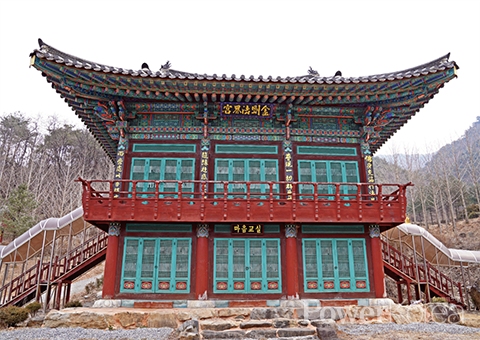 |
‘Hyeon-eomsa’ achieved after receiving the heavenly myogua as a Buddha’s heart seal
There is this phrase in ‘Hyeoneomsa Temple’ of Jineon Buddhism (46, Unbong-gil 186beon-gil, Haeundae-gu, Busan). ▲Only when one recognizes all dharmas, one can recognize non-birth and immortality, and only when one knows non-birth and immortality, one can know that dharmas are impermanent. The mind of impermanence, rightness, and bodhi is the mind united with the principal Buddha. I am your main zone. Avalokitesvara Bodhisattva is going. It is a selfless person (there is no evil to be discarded, and there is no good to be taken), it is equal and silent, and since it is an unmanned person, it is possible to see the original Buddha. Muin and bonbulsaeng are not different. It’s equal, and it’s not about words or explanations.”◎ This is a writing written by Venerable Doseong with a brush in the spirit of clearing his mind and striving to attain perfect perfection in the spirit of Mu Sangjeongdeungbori: Supreme Right Enlightenment. There is a mandala made of barren sand in the main sanctuary of Hyeoneomsa Temple. This was also completed over seven days in 2012 by the monk inviting a Tibetan monk, a disciple of the venerable Dalai Lama. Currently, Buddhists are enshrined for esoteric practice and mandala meditation. Hyeoneomsa is the headquarters of Shingon Buddhism, which was established by a monk after returning from atrocities. The monk said, “Hyeoneomsa is the practice according to the words of the Buddha, ‘Do the Bodhisattva.’” On September 7, 1981, the monk named the hut at the foot of Gumi Mountain as Daeilsansa Temple. In December of that year, he settled down in Bugok-dong, Dongnae-gu, Busan, while translating the original text of Jisong Uigwe, the main object of meditation. And in 1982, he created a statue of Junje Bodhisattva, the main zone of the 5 Buddhas, 3 trees and 2 monuments, and moved from place to place in Hoi-dong and Seo-dong. Everywhere he went, he enshrined the main Buddha Jinnon and Jisong Uigwe, set up an altar, and told people the story of meritorious deeds and attainment of Buddhahood. In addition, he earnestly made a vow to obtain a bodhisattva to enshrine the ‘wooden chilguji barren great castle Junje Wang Bodhisattva, 5 Tathagata, 3 necks and 18 stele statues’. Then, at dawn on June 6, 1985, a hand holding a large celestial shrine came down from the air with a mysterious sound. At that time, while receiving the Cheonmyogwa, the sound of the crown was heard. ▲Bodhisattva Suji Cheonmyogwa: Bodhisattva’s hands hold Cheonmyogwa Bodhi Bodhi Gwawonseong: Ageumjeongrye Seogwiui as a sign of successful enlightenment: I now swear to take refuge and pay homage. Wona Gwangsujeseongwa: I wish that I would achieve all Buddhas through extensive training.◎ On that day, the monk suddenly had the idea that he would be able to find a person who would serve the principal Buddha. Then he went straight to the road and got on the bus. When he got off the bus, he saw an old man sitting on the side of the road looking for a place to enshrine the Buddha. When the monk visited the house, the owner said, “In my dream this morning, a gray-haired old woman dressed in white came and said, ‘A monk will come to your house to attend Buddha, so give it to me. Your house becomes a temple” and disappeared. Monk Doseong translated ‘Bulseol Chilguji Barrenness Daejunje Darani Sutra and Junje Mantra Jisong Uigwe, Chilguji Dokbubeop and Daejunje Bodhisattva Fountain Siljihyeonmun’, which were that he received a message with his devotion to the old law. And the virtuous practice to be practiced with ‘Junje Mantra Constitutive Beomja Spore Law’ and ‘Junje Contemplative Corresponding Method’ were finally achieved. The following year, on August 2, 1987, the monk enshrined the ‘5 Buddhas, 3 Trees, 18 Bisangsang, Chilgujibulmo Daeseongjunje King Bodhisattva’. And he left in the book of ascetic practices, “Since I received the Jisong Uigwe and the Cheonmyogwa together, the principal Jonim corresponds at any time.”
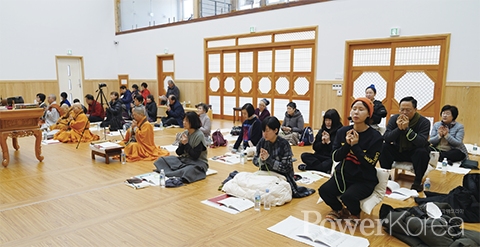 |
Gyeongju Josajeon, Sangju and Yeongcheon, doryang and Maum Class
Esoteric Buddhism arose as the last wave of Mahayana Buddhism in India in the 7th and 8th centuries and was introduced to China by several Chinese old Buddhist monks and Indian Buddhist monks such as Seonmu, Geumgangji, and Buddhist monks. The Korean Peninsula was spread by Hyecho, Hyetong, Myeongrang, and Hyesuk from the Shilla Dynasty. Thus, it has functioned as the central axis of Korean Buddhism along with Hyeongyo from Silla to Goryeo. In Korean Esoteric Buddhism, not only ideology, but also elaborately developed religious images and mantras played an important role in actual practice. However, like other sects, it disappeared due to the consolidation and abolition of the Joseon Dynasty, and was handed down only through religious rites and popular beliefs. And after the Japanese colonial period and liberation, it established itself as a sect of enlightenment during the healing process of Sohn Kyu-sang, a synagogue of the Jingak Order of Korean Buddhism. Based on this, ‘Chongji School’ and ‘Jineon School’ were branched out, and ‘Jiseungjong’ (Doseong Kim Chong-tae), a Shingon Buddhist religion who recites the Junje mantra of Cheonsu-gyeong, was founded in 1986 at ‘Hyeoneomsa Temple’ in Busan. ‘Shingon Buddhism’ practices an esoteric religion with the principal Buddha being Guan Yin, the Bodhisattva of the Seven Guji Buddhas, Daeseong Junjewang. With ‘Hyeoneomsa’ as its axis, Jineon Buddhism has Beophwasa Temple in Danyang, Josaseongjeon in Gyeongju, the site of Namsan (Euncheon-dong, Bulmojeongsa Temple, a crypt for monk Doseong, Maum Class in Blue Forest, Chongdeoksa Temple in Yeongcheon, and Jabisa Temple in Sangju. Ascetic practice enables one to learn the truth through the three principles, practice the six paramitas, practice the four eunuchs (痼醑鋮鉏), annihilate the ten evils and five evils, purify the present world, and make a vow to the Bodhisattva, the Pure Land, and the Immediate Buddhahood. For the mantra, people recite ‘Om Mani Padme Hum’ according to the Junje Mantra Jisong Uigwe. Through this, Avalokiteshvara Bodhisattva’s Dharani karma will be extinguished, and one will attain Buddhahood. As for the small sutras, they recite Banyasimgyeong, Bulseolchilgujibulmosim Daejunjedaranigyeong, Chilgujidogbubeop, Daejunjebosal Fountainjichamhoehyeonmun, etc., and study the theory of the great and small sutras and learn engagement. In Shingon Buddhism, the ‘Six Great Smokes’ (earth, water, fire, wind, and air consciousness) are viewed as the Buddha’s body and regarded as the entire body of the universe as well as the body of each individual. Here, Consciousness is a mental element that has the nature of knowing and acts to make a decision, and the previous five elements are material elements and have their own nature. Earth is the ability to create all things, Water is the habit of subjugation, Fire is the action of cooking and is untainted by dirt, Wind is filtering out everything, eliminating ties and Gong (Gong). Empty refers to the action of embracing everything without obstruction. If the Buddha’s body, mouth, and mind are the three secrets, then the body, mouth, and mind of sentient beings are called the three karmas. By practicing the three secret karmas, sentient beings discover that they are originally equipped with Buddha-nature or attain enlightenment. At Chongdeoksa Temple in Yeongcheon, Buddhists gather regularly to listen to Buddhist ceremonies and monks’ Dharma sermons, and hold the Hwangukin’s goma ceremony. On Namsan Mountain in Gyeongju, stone carvings containing vows made by Buddhists are also lined up. Venerable Doseong said, “All people are Guanyin and barren. Junze Avalokitesvara Bodhisattva holds five Buddhas above his head. If you memorize Junje Dharani with one thought, all the Buddhas will be with you and become your teachers and friends. It’s good to have a wise friend by your side, but how good it would be if Buddha and Bodhisattva were always with you. I’m happy just thinking about it.”
홍기인 기자 forum1004@naver.com



